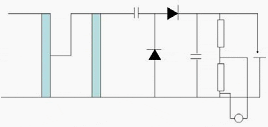DC Tests
DC tests are used mainly to do “pressure tests” on high voltage cables. Although the cables operate with AC, AC testing is not practical.
The high capacitance of the cables necessitates AC test sets with a high kVA rating to be able to supply the capacitive current. In the case of DC, once the cable is charged, only the losses have to be supplied.
DC test sets usually consist of half wave rectification, using HV selenium rectifiers.
Typical DC test set-up is shown in Figure 1.

Figure 1 - Typical circuit for DC tests
An AC high voltage test transformer is again supplied via a variac and a rectifier is used together with a filter capacitor C to limit the ripple to acceptable values. The earthing switch ES is a safety feature and closes automatically when the power is switched off to discharge the capacitor C.
Note that the peak inverse voltage required of the rectifier is 2 Vm.

Figure 2 - Typical doubling circuit for DC tests
Doubling and multiplier circuits (as used in TV’s and household appliances) are also used to obtain an even higher voltage. A typical Cockcroft-Walton (in Germany: Greinacher) doubling circuit is shown in Figure 2.

Figure 3 - Typical waveforms and a typical doubling circuit DC test source
Very interesting topic and thanks for great posting.
ReplyDeleteHV Testing